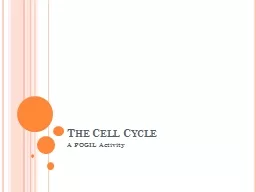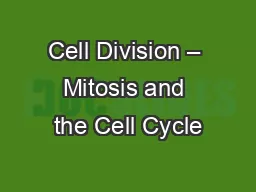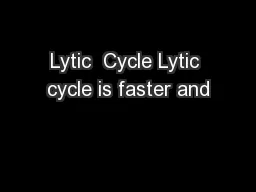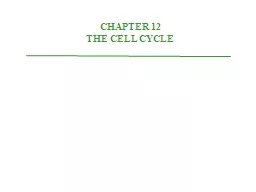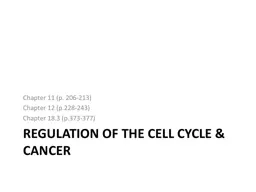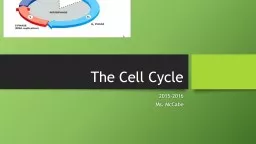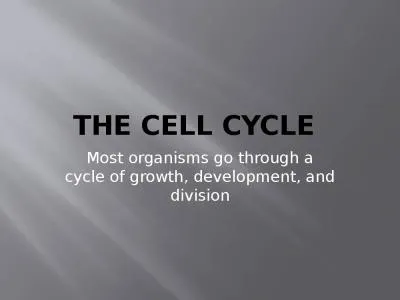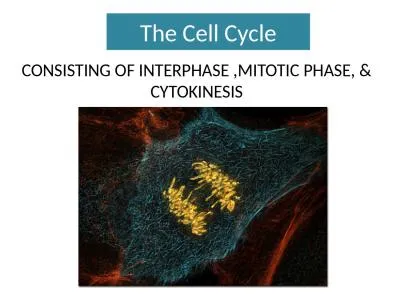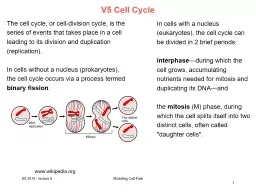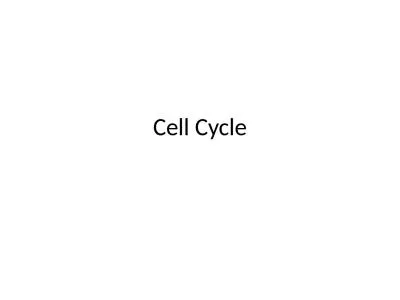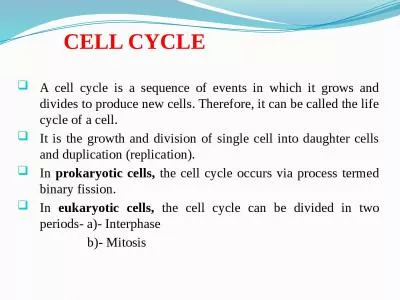PPT-The Cell Cycle A POGIL Activity
Author : susan | Published Date : 2022-04-06
1 How many phases are in the cell cycle as shown in the diagram in Model 1 Four 2 Starting at the starred cell what is the order of the stages of a cells life G1
Presentation Embed Code
Download Presentation
Download Presentation The PPT/PDF document "The Cell Cycle A POGIL Activity" is the property of its rightful owner. Permission is granted to download and print the materials on this website for personal, non-commercial use only, and to display it on your personal computer provided you do not modify the materials and that you retain all copyright notices contained in the materials. By downloading content from our website, you accept the terms of this agreement.
The Cell Cycle A POGIL Activity: Transcript
1 How many phases are in the cell cycle as shown in the diagram in Model 1 Four 2 Starting at the starred cell what is the order of the stages of a cells life G1 S G2 M 3 During which phase does the size of the cell increase. Unit 5. Welcome Back! . Musical Chairs. TODAY:. Notes on Cell Cycle. Become medical school students on oncology . rotation. Homework for next time: Watch Bozeman video on cell cycle, mitosis and meiosis. There *may* be a quiz.. Section 5.1. 1. Objectives. SWBAT describe the stages of the cell cycle.. SWBAT compare rates of division in different types of cells.. SWBAT identify factors that limit cell size.. 2. Starter. Why do you always have to cut your hair, your fingernails, and the lawn?. A Chromosome and Sister Chromatids. Key Points About Chromosome Structure. A . chromosome consists of DNA that is wrapped around proteins (. histones. ) and condensed. Each . histone. and the DNA wrapped around it make up a . simpler. Ex: the flu. A virus with this type of cycle makes you sick right away. What about the other type of life cycle?. The . Lysogenic. Cycle. The . lysogenic. cycle is slower and more complex. Manages the group. . Ensures that members are fulfilling their roles, that the assigned tasks are being accomplished on time, and that all members of the group participate in activities and understand the concepts. . Unicellular organism- cell division reproduces . an entire . organism. Multicellular. organisms- cell . division . can . produce . growth or progeny. Cell . division functions in reproduction, growth, and repair. Chapter . 11 (p. 206-213) . Chapter . 12 (p.228-243). Chapter . 18.3 (p.373-377). G. 1. checkpoint. G. 1. G. 2. G. 2. checkpoint. M checkpoint. M. S. Control. system. Figure 12.15. External Regulators. La gamme de thé MORPHEE vise toute générations recherchant le sommeil paisible tant désiré et non procuré par tout types de médicaments. Essentiellement composé de feuille de morphine, ce thé vous assurera d’un rétablissement digne d’un voyage sur . Ms. McCabe. Do Now Cells Quiz 20 Points. Skipping lines, number 1-10. Name, Date, Period. The title is: . Cell Quiz. Answer 1-5 in complete sentences. For 6-10, write the word . and. the matching definition. Phases of the cell cycle. Interphase. Mitotic Phase. Interphase. G1. - a cell grows and develops. S. - a cell continues to grow but copies its DNA. G2. - still growing but begins to store energy and get ready to divide. The Mitosis Puzzle. Lay blank sheet lengthwise .. Write Interphase, Prophase, Metaphase, Anaphase, & . Telophase. across the top of the sheet.. Cut out the cell diagrams and tape/glue them across the top under the appropriate phase label.. The cell cycle, or cell-division cycle, is the series of events that takes place in a cell leading to its division and duplication (replication). . In cells without a nucleus (prokaryotes), the cell cycle occurs via a process termed . Interphase. Mitosis. Prophase. Metaphase. Anaphase. Telophase. Cytokinesis. Interphase. Longest phase of the cell cycle. Cell grows to mature size. Replicates DNA. Prepares for division. Mitosis. Mitosis is the process of cell . It is the growth and division of single cell into daughter cells and duplication (replication).. In . prokaryotic cells, . the cell cycle occurs via process termed binary fission.. In . eukaryotic cells, .
Download Document
Here is the link to download the presentation.
"The Cell Cycle A POGIL Activity"The content belongs to its owner. You may download and print it for personal use, without modification, and keep all copyright notices. By downloading, you agree to these terms.
Related Documents

